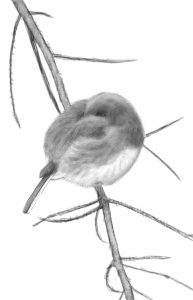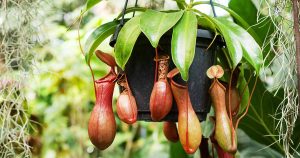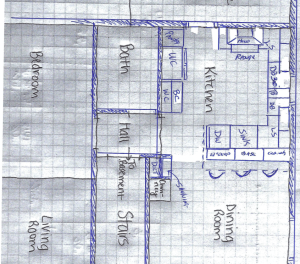
Grown for its intensely aromatic, starry flowers, jasmine (Jasminum spp.) is an easy-care vine or shrub that benefits from regular pruning.
Regular trimming promotes lush twining stems laden with pretty foliage that fills out with sweet-smelling pink, white, or yellow flowers, scenting the air with a heady bouquet – and attracting butterflies, hummingbirds, and other helpful pollinators.

We link to vendors to help you find relevant products. If you buy from one of our links, we may earn a commission.
Pruning helps to manage the size of these vigorous climbers and to maintain a tidy form.
It also creates dense, lush growth by promoting branching – and the more branches there are, the more flowers you’ll enjoy.
And more jasmine flowers are always appreciated!
So if you’re ready to create a sumptuous wall or screen of fragrant finery, keep reading for how to prune jasmine for lush, showy plants.
Here’s what I’ll cover:
Jasmine Fundamentals
One of the most endearing traits of jasmine is its fast growth, adding 12 to 24 inches of new growth each year.
But this fast growth can also cause lankiness, long branches with flowers only on the higher stems.

Annual pruning helps to keep plants densely foliated, and promotes flowers the entire length of the stems, including on the lower reaches where the scent can be appreciated.
It’s also needed to control their size and spread and to prevent straggly and tangled growth.
Both the common summer varieties, J. officinale and J. grandiflorum, and winter types (J. nudiflorum) benefit from regular pruning, but it has to be done at different times of the year – more on that coming up.
Always use sharp, clean shears and wear protective gear like safety glasses, gloves, and long sleeves to avoid scratches and poked eyes.
And although I’m referring to vines in this guide, shrub varieties like angel wing (J. nitidum) and Arabian jasmine (J. sambac) are pruned in the same manner.
Learn more about these species and more in our guide to 13 types of jasmine vines and shrubs.
And if you need a refresher about how to grow jasmine in your landscape, check out our guide.
Early Spring Cleanup
In early spring just as the buds start to swell with new growth, a light grooming is useful to tidy up plants, control the direction of growth, and ensure a vigorous start to the growing season.
Starting at the bottom of the vine and working your way up, remove broken or dead stems and winter damaged tips as well as crossed branches.

Next, head back the tips of last year’s growth. Remove only as much length as needed to keep the stems within the shape you desire, cutting them just above a leaf bud with clean, sharp shears.
Even though jasmine produces two leaves opposite one another on a stem, you can still control the direction of growth.
To train a stem’s growth, choose a strong bud that’s pointing the way you want the vines to travel and pinch off the smaller one close to the stem – the remaining strong bud will continue growing in the direction you’ve chosen.

This is also the best time to reinforce support for your climbing vines – mature growth can become heavy and sag from the weight, pulling vines down and away from their support systems.
Check for any weak spots, gravity pulls, or vines that are bulging away from the trellis and reattach them with plant clips, garden twine, or velcro.
When to Prune Jasmine
As the names suggest, summer-flowering varieties bloom in summer and early fall, and winter flowering varieties flower in winter.

Both types flower on the previous year’s wood and are best pruned right after they finish blooming.
This makes midsummer to mid-fall the time to prune summer blooming types.
But don’t delay too long after flowering to cut back your summer vines or shrubs.
Flowering takes place primarily on old wood – sometimes with a light, later flush on the tips of the current year’s growth – so giving your plants the longest possible time to develop new growth ensures an early and luscious floral display the next year.
Also, these plants are typically hardy in Zones 7 to 11, and in regions at the cooler end of their hardiness range the new growth should be given plenty of time to harden off before frosty temperatures arrive. Harsh temperatures can easily kill or damage tender new tips.
You can learn more about winter care in our guide.
For winter-flowering varieties, early to mid-spring is the best time to prune, eliminating the need for a spring cleanup – tidying can be done at the same time as pruning.
Throughout the growing season, feel free to cut back the odd wayward stem or any that have become broken or damaged.
Prune for Shape and Size
After flowering, to prune the shape and size of your jasmine start at the bottom of the plant and work your way up.
For a light trimming, snip stems that are growing outside of the trellis or support boundaries, choosing a strong set of leaves within the support framework to keep regrowth on the path you want. Snip just above a set of healthy leaves.

You can also bring longer stems back into the fold by wrapping them around stronger ones or attaching them to a trellis with plant clips, twine, or velcro.
If you want a more robust reduction in shape and size, cut back lateral and main stems to where they meet a strong side shoot, removing as much as one-third of the overall size, depending on the results you desire.
Take your time with this and do the cutting in measured amounts – step back frequently to view your work and avoid over-pruning.
At the same time, thin out damaged, overcrowded, or unruly shoots. If you hit a tightly woven tangle, remove the stem in sections rather than trying to pull it out in one piece, which can pull away healthy growth as well.
After just a couple of years of regular pruning, you’ll find that maintaining your vines becomes much easier and you can “sculpt” their appearance into a variety of attractive shapes to climb, drip, fan, or flow as desired.
For vines that are growing on a tall arbor or up a trellis, an extension or telescoping lopper is ideal for reaching the upper stems.
Extendable Pole Saw and Pruner
Something like this extendable pole saw and pruner, available from Garrett Wade, which extends from four to eight feet.
And if you’re growing other species also commonly known as jasmine, we have guides to pruning star jasmine and Asiatic jasmine as well.
Pinching New Vines
For new plantings, climbing vines benefit from having their growing tips pinched in their first two years of growth.
After new growth starts, pinch out or snip the top one to two inches of growth on all main and lateral stems.
Pinching out the tips early in their life promotes branching, lush foliage, and rapid growth.
Rejuvenate Overgrown Plants
For overgrown plants that have outgrown their space, both summer and winter types can take a hard pruning and bounce back with vigorous growth.
This type of pruning is done in early spring, to give the plants plenty of time to recuperate and produce ample new growth before winter.

To hard prune, cut back all vines to eight to 24 inches above the base.
As new shoots emerge, select the strongest stems to train onto their support structure and remove weak or unwanted shoots.
New growth appears in the same season as the hard pruning, but it can take two or three years for full flowering to resume.
Lush Foliage With an Abundance of Blooms
Pruning jasmine annually is the best way to maintain the shape you want, promote lush foliage, and ensure an abundance of blooms from top to bottom!

Give your summer vines a spring cleanup to tidy plants and remove damaged wood.
Then prune to shape and size your plants after flowering – in midsummer to fall for summer flowering varieties and in spring for winter flowering types.
Should your shrubs or vines need a rejuvenating hard prune, do so in early spring to give them a full growing season to recover.
And for more jasmine cultivation know-how, add these guides to your reading list next:






